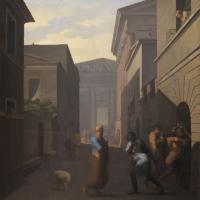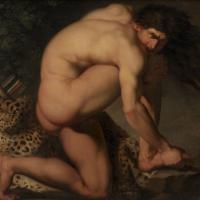Nicolai Abraham Abildgaard
The Wounded Philoctetes
$480.00
Nicolai Abraham Abildgaard
Nicolai Abraham Abildgaard (1743-1809)
Nicolai Abraham Abildgaard (September 11, 1743 – June 4, 1809) was a Danish neoclassical and royal history painter, sculptor, architect, and professor of painting, mythology, and anatomy at the New Royal Danish Academy of Art in Copenhagen, Denmark. Many of his works were in the royal Christiansborg Palace (some destroyed by fire 1794), Fredensborg Palace, and Levetzau Palace at Amalienborg.

Abildgaard had studied at the Academy from 1764 to 1767, then worked there as an apprentice, and moved to Rome in 1772–1777, where he studied sculpture, architecture, decoration, frescoes (at Palazzo Farnese) and murals. He returned to the Academy in Copenhagen, promoted to professor in 1778, and elected as Academy Director during 1789–1791 and 1801–1809. He was also assigned as a royal artist/decorator during 1780 to 1805. Abildgaard was married twice, in 1781 and 1803.
Nicolai Abraham Abildgaard was born on September 11, 1743, in Copenhagen, Denmark, as the son of Anne Margrethe (née Bastholm) and Søren Abildgaard, a noted antiquarian draughtsman.
Abildgaard was trained by a painting master before he joined the Royal Danish Academy of Art (Det Kongelige Danske Kunstakademi) in Copenhagen, where he studied under the guidance of Johan Edvard Mandelberg and Johannes Wiedewelt. He won a series of medallions at the Academy for his brilliance from 1764 to 1767. The Large Gold Medallion from the Academy won in 1767 included a travel stipend, which he waited five years to receive. He assisted Professor Johan Mandelberg of the Academy as an apprentice around 1769 and for painting decorations for the royal palace at Fredensborg. These paintings are classical, influenced by French classical artists such as Claude Lorrain and Nicolas Poussin. Mandelberg had studied in Paris under François Boucher.
In 1778, soon after joining the Academy, he was appointed to a professorship. He taught mythology and anatomy in addition to painting of the neoclassical style. Beyond his position at the Academy, he was very productive as an artist from 1777 to 1794. He produced not only monumental works, but also smaller pieces such as vignettes and illustrations. He designed Old Norse costumes. He illustrated the works of Socrates and Ossian. Additionally he did some sculpting, etching, and authoring. He was interested in all manners of mythological, biblical, and literary allusion.
He taught some famous painters, including Asmus Jacob Carstens, sculptor Bertel Thorvaldsen, and painters J. L. Lund and Christoffer Wilhelm Eckersberg.After his death, Lund and Eckersberg went on to become his successors as Academy professors.
Abildgaard married Anna Maria Oxholm on March 23, 1781.
His showdowns with the establishment culminated in 1794, when his allegorical painting "Jupiter Weighs the Fate of Mankind" (Jupiter vejer menneskenes skæbne) was exhibited at the Salon. He was politically isolated and cut out of the public debate by censors.
The fire at Christiansborg Palace, in February 1794, also had a dampening effect on his career, for seven of the ten monumental paintings of the grandiose project were destroyed in that accident. The project was stopped and so were his earnings.
However, after that devastating fire accident, he started getting decorative assignments and also got the opportunity to practice as an architect. He decorated the Levetzau Palace (now known as Christian VIII's Palace) at Amalienborg (1794–1798), recently occupied home of King Christian VII of Denmark's half-brother Frederik. His protégé Bertel Thorvaldsen headed the sculptural efforts.
He also planned for rebuilding the Christiansborg Palace, but he could not get the assignment.
At the start of the 19th century, his interest in painting was restored when he painted four scenes from Terence's comedy Andria. This coincided with his second marriage in 1803 to Juliane Marie Ottesen, which was a very happy situation for the aging Abilgaard. He had two sons and a daughter from the marriage. He bought a lovely little place in the country for the family, Spurveskjul (Sparrow Hideaway).
In 1804 he received a commission for a series of painting for the throne room in the new palace, but disagreements between the artist and the crown prince put a halt to this project. He continued, however, to provide the court with designs for furniture and room decorations.
He was once again selected to serve as the Academy's director from 1801 until his death in 1809, at Frederiksdal. Nicolai Abraham Abildgaard is buried in Copenhagen's Assistens Cemetery.
Though Nicolai Abildgaard won immense fame in his own generation and helped lead the way to the period of art known as the Golden Age of Danish Painting, his works are scarcely known outside of Denmark. His style was classical, though with a romantic trend. According to the Encyclopædia Britannica Eleventh Edition, "he was a cold theorist, inspired not by nature but by art. He had a keen sense of color. As a technical painter, he attained remarkable success, his tone being very harmonious and even, but the effect to a foreigner's eye is rarely interesting." A portrait of him painted by Jens Juel was made into a medallion by his friend Johan Tobias Sergel. August Vilhelm Saabye sculpted a statue of him in 1868, based on contemporary portraits.





